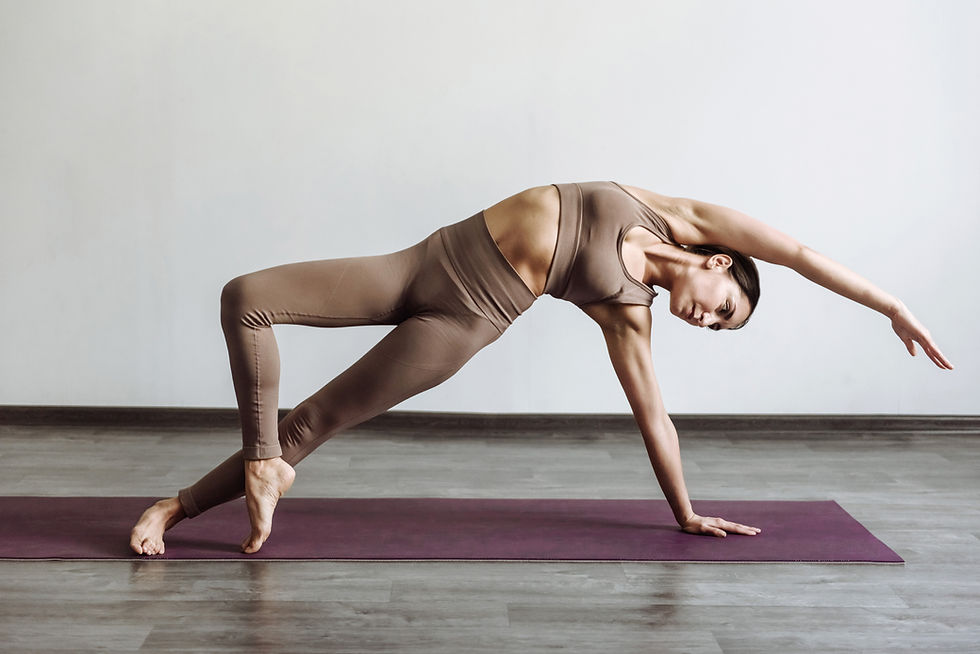What is Yoga Nidra?
- Yoga Haven

- Sep 19, 2023
- 4 min read
Yoga Nidra, often referred to as "yogic sleep," is a deeply relaxing and meditative practice that originates from the ancient teachings of yoga. Unlike the more physical styles of yoga, Yoga Nidra is a slow meditation meant to bring about conscious relaxation and allow students to enter a state between wakefulness and sleep. The practice helps to achieve profound relaxation where the body's stress response is minimized, and the mind enters a state of heightened receptivity. While students may appear to be asleep during Yoga Nidra, the goal is to maintain a state of awareness and presence, facilitating deep emotional, mental, and physical healing.
At its core, Yoga Nidra helps students achieve relaxation and self-awareness. By directing attention to different parts of the body and developing an awareness of the breath, students are able to detach from worries and stress. The Yoga Nidra practice is rooted in ancient yogic wisdom but has gained popularity in modern times due to its holistic nature for healing. Yoga Nidra offers a doorway to explore the inner landscapes of the mind, fostering a harmonious connection between body, mind, and spirit.
What are the Benefits of Yoga Nidra for Sleep?
Yoga Nidra offers remarkable benefits for improving sleep quality by promoting deep relaxation and reducing insomnia-related issues. Through guided meditation, Yoga Nidra calms the nervous system, alleviates stress, and minimizes the intrusive thoughts that disrupt sleep. By relaxing different parts of the body and focusing on breath awareness, students are led to release physical tension and mental stresso.The practice of Yoga Nidra may help to regulate sleep patterns, enhance the body's ability to transition through sleep cycles smoothly, and facilitate a sense of tranquility that promotes both falling asleep and staying asleep throughout the night.
A Short Practice of Yoga Nidra for Sleep
If you’re wondering how you can use yoga nidra for sleep at home, here is a step-by-step practice to try:
Find a comfortable lying down position, with your arms at your sides and palms facing up. Make sure you're well-supported.
Close your eyes and take a few deep breaths to settle in. Let go of any tension you might be holding in your body.
Bring your awareness to your right hand. Feel the sensation in your right thumb, index finger, middle finger, ring finger, and pinky finger. Let your hand become heavy and relaxed.
Shift your awareness to your left hand. Feel the sensation in your left thumb, index finger, middle finger, ring finger, and pinky finger. Let your hand relax completely.
Now, bring your attention to your right foot. Feel the sensation in your toes, the sole of your foot, your heel, and your ankle. Let your right foot become heavy and relaxed.
Move your awareness to your left foot. Feel the sensation in your toes, the sole of your foot, your heel, and your ankle. Let your left foot relax deeply.
Take a deep breath in, and as you exhale, imagine a wave of relaxation spreading from your toes to the top of your head. Feel every part of your body settling in.
Visualize yourself in a peaceful place, such as a beach, forest, or any serene setting you prefer. Imagine the sights, sounds, and sensations of this place.
Bring your attention to your breath. Feel the gentle rise and fall of your chest and belly as you breathe naturally. Count your breaths backward as you breath in and out.
Imagine each breath taking you deeper into relaxation. With each breath, let go of any worries or thoughts, perhaps letting them go one by one.
Repeat a simple affirmation to yourself, like "I am calm and at peace." Repeat it silently, allowing the words to resonate within you.
When you’re ready, slowly bring your awareness back to your body. Take a few deep breaths, gently wiggle your fingers and toes, and open your eyes.
Feel free to modify the practice according to your preferences and needs, for example, instead of waking simply allowing yourself to fall asleep after your meditation. If you would rather practice yoga nidra with others and/or be led by an instructor, check out Yoga Haven which offers frequent workshops and special events including Yoga Nidra.
Where Can I Find Yoga Nidra Near Me?
While practicing Yoga Nidra at home can be convenient, attending a Yoga Nidra workshop can be a unique and elevated experience. Many of us lack the quiet and serene environment at home to be able to completely sink into relaxation which is why many students seek this type of practice and why yoga teachers love to offer it. When you attend a Yoga Nidra workshop at Yoga Haven, you’ll be led by an experienced instructor in a beautiful and distraction-free space and you’ll become part of a community of like-minded individuals seeking peace and relaxation. You may even find yourself becoming more interested in other types of yoga or meditation after attending a workshop. There are so many ways to embark upon your yoga journey and we are here to help guide you.
If you’re interested in Yoga Nidra, sign up for the upcoming Yoga Nidra workshop led by Geri Ross at Yoga Haven. And if you can’t make this one, continue to be on the lookout for upcoming special events by following us on social media or inquiring at the studio. We look forward to seeing you soon!
Namaste.






Comments